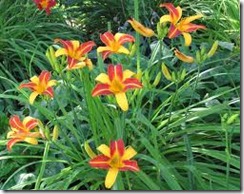Fall planting of daylilies allows plenty of time to prepare a bed and is recommended for southern gardens where the weather is reliably mild. Fall-planted divisions are more likely to bloom the following summer than those planted in spring. Enjoy fall-planted daylilies during the summer, and take divisions or expand the collection during the lazy days of early fall rather than the hectic days of spring planting.
Convenience
-
When preparation for the daylily border begins in spring for fall planting, there is plenty of time for solarization or several applications of glyphosate. The summer gardener, faced with cultivating the daylily plot to the depth of a foot encounters neither frozen soil nor lines at the rental store for a rotary tiller. The addition of 2 inches of compost or well-rotted manure contributes enough nitrogen to encourage strong root growth. The compost or manure establishes a well-drained base, which is particularly important in marshy areas or locales with heavy soils where raised beds must be built. Returns on soil tests are also likely to be faster than in spring when gardens go in and lawns are started.
Northern versus Southern Planting
-
In frost-free areas, gardeners can plant evergreen daylilies through the beginning of winter. By the end of September, the 90-degree temperature that, combined with southern humidity, rots newly planted crowns has passed. Northern gardeners who chose fall planting must plant closer to the end of summer and take some precautions, warns the American Hemerocallis Society. Northern gardeners should choose only hardy cultivars, mulch carefully and get the plants in the ground 60 to 90 days before the first average freeze date in their area.
Divisions
-
Although some cultivars multiply slowly, most reproduce easily. When bloom begins to decline, on an average of every three to five years, daylilies benefit from division. The best time to complete the task, say the U.S. National Arboretum horticulturists, is after bloom has finished in mid to late summer. Dividing daylilies in very early spring may set blooming back a year or more but propagating them in late summer through early fall accommodates the important fall tasks of growing roots and gathering nutrients. Staff members at the arboretum suggest finishing planting divisions by early September. Houston daylily hybridizer Bill Jarvis agrees that planting divisions in fall promotes root development before the ground freezes and suggests finishing fall transplanting of divisions six to eight weeks before the first freeze.
Choosing Plants
-
The plants chosen are as important as when they are planted. Bill Jarvis suggests buying locally from nurseries and daylily clubs or from reputable mail order sellers who label plant sources. Tender evergreen varieties that stay green in the South may survive as deciduous "dormants" in northern zones but bloom poorly and weaken over time. On the other hand, plants hardy in the North may not get the proper chilling in southern winters to survive.


Deprecated: strpos(): Passing null to parameter #1 ($haystack) of type string is deprecated in /home/agriviek8Qv/agriviet.net/public_html/wp-includes/comment-template.php on line 2522